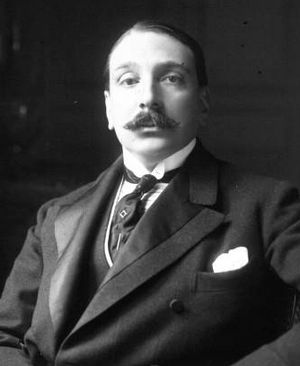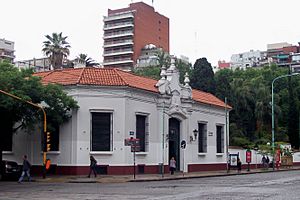Enrique Larreta facts for kids
Quick facts for kids
Enrique Larreta
|
|
|---|---|

Larreta in 1914
|
|
| Born | Enrique Rodríguez Larreta 4 March 1875 Buenos Aires, Argentina |
| Died | 6 July 1961 (aged 86) Buenos Aires, Argentina |
| Occupation | Writer, historian |
| Language | Spanish, French |
Enrique Rodríguez Larreta (born March 4, 1875 – died July 6, 1961) was an important Argentine writer, historian, and diplomat. He was also a big collector of art. He was even nominated for the Nobel Prize in Literature ten times, which is a huge honor! His beautiful house in Buenos Aires is now a museum of Spanish art.
Contents
Early Life and Education
Enrique Larreta was born in Buenos Aires, Argentina. His family was well-known and came from Uruguay. He later married Josefina Anchorena Castellanos, who came from one of Argentina's most important families.
Enrique studied law at the University of Buenos Aires. He graduated in 1897. After that, he taught medieval history at a famous school called the Colegio Nacional de Buenos Aires.
A Famous Writer and Diplomat
Larreta became very famous as a writer with his novel La gloria de don Ramiro (The Glory of Don Ramiro). This book was published in 1908. It is a great example of a writing style called Hispanic modernism. The story is about a soldier named Don Ramiro who lives during the time of Philip II of Spain. It explores the challenges between worldly desires and a more spiritual life.
From 1910 to 1919, Larreta served as Argentina's Ambassador to France. During this time, he lived in places like Biarritz, France, and Ávila, Spain. In Ávila, he met another famous writer, Miguel de Unamuno. There is even a street named after him in Ávila!
Plays and Later Life
Enrique Larreta also wrote plays. His first play, La lampe d'argile, was written in French and shown in Paris in 1917. Other plays he wrote include La luciernaga (Firefly) in 1923 and El linyera (The Bum) in 1932. His play Santa Maria del Buen Ayre (1935) is often thought to be his best.
Larreta was a member of important groups like the National Academy of History of Argentina and the Royal Spanish Academy. He spent many of his later years in Madrid, Spain. Other cities in Spain, like Alcalá de Henares, Madrid, and Segovia, also have streets named after him.
Larreta's Legacy
Enrique Larreta passed away in 1961. He was buried in the famous La Recoleta Cemetery in Buenos Aires.
His home in Buenos Aires became the Museo de Arte Español Enrique Larreta (Enrique Larreta Museum of Spanish Art) in 1962. This beautiful house was built in 1886. It has a special Andalusian palace garden, which is like a peaceful oasis in the busy city. When Larreta returned from Europe, he brought a huge collection of Spanish art and furniture. This collection, with pieces from the Renaissance and Baroque periods, makes the house feel like a Spanish museum. Many of the artworks are from the same time period as his famous novel, Don Ramiro.
Works
- Artemis (1896)
- La Gloria de Don Ramiro: Una vida en tiempos de Felipe II (1908; The Glory of Don Ramiro: A Life in the Times of Philip II)
- La que buscaba Don Juan (1923; The One Don Juan Sought)
- Zogoibi (1926; The Unfortunate One)
- Santa Maria del Buen Aire: Drama en tres actos (1936)
- Las dos fundaciones de Buenos Aires (1938)
- La calle de vida y de la muerte. Poesias (1941)
- Tenia que suceder (1943; It had to Happen)
- La naranja (1948; The Orange), a book of his memories and essays
- Gerardo o la torre de las damas (1953; Gerardo, or the Tower of the Ladies)
- Obras Completas (1954; Complete Works)
- En la pampa (1955; On the Pampas)
See also
 In Spanish: Enrique Larreta para niños
In Spanish: Enrique Larreta para niños


